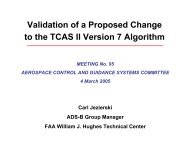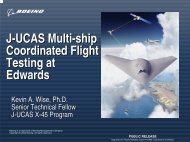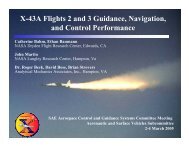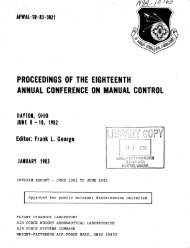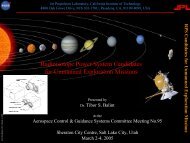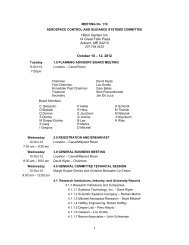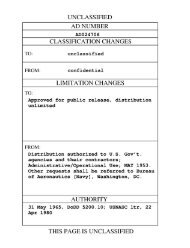Report of the Second Piloted Aircraft Flight Control System - Acgsc.org
Report of the Second Piloted Aircraft Flight Control System - Acgsc.org
Report of the Second Piloted Aircraft Flight Control System - Acgsc.org
Create successful ePaper yourself
Turn your PDF publications into a flip-book with our unique Google optimized e-Paper software.
coupling between <strong>the</strong> tm ends and through <strong>the</strong> line shown above <strong>the</strong> main<br />
part <strong>of</strong> <strong>the</strong> figure. The output spring, shown in. <strong>the</strong> schematic is not<br />
shown on <strong>the</strong> figure at <strong>the</strong> bottom <strong>of</strong> <strong>the</strong> page.<br />
*<br />
There are a number <strong>of</strong> o<strong>the</strong>r systems which accomplish essentially <strong>the</strong><br />
same results, but <strong>the</strong> difficulty <strong>of</strong> realizing a decent range <strong>of</strong> element<br />
values has led us to consider a schane <strong>of</strong> this sort in s om detail. For<br />
<strong>the</strong> stabilization <strong>of</strong> <strong>the</strong> control system with <strong>the</strong> numerical parameter values<br />
used as an example during this paper, <strong>the</strong> spring and damper values for <strong>the</strong><br />
twin-T shown here coma out to be <strong>of</strong> order <strong>of</strong> magnitude yielding time constants<br />
<strong>of</strong> about 1/10 secord. Specific values depd on <strong>the</strong> location in <strong>the</strong> ~ystem.<br />
The element values can be readily determined'using <strong>the</strong> methods <strong>of</strong> network<br />
syn<strong>the</strong>sis well known in electrical engineering.<br />
Clearly a findamental question is <strong>the</strong> proper location <strong>of</strong> thls twin-T or<br />
any o<strong>the</strong>r form <strong>of</strong> compensation network in <strong>the</strong> overall loop. The answer to<br />
thls westion depends on a number <strong>of</strong> <strong>the</strong>oretical factors (e.g., <strong>the</strong> effect<br />
<strong>of</strong> loading at ei<strong>the</strong>r end <strong>of</strong> <strong>the</strong> network on its characteristics, <strong>the</strong> effect<br />
<strong>of</strong> <strong>the</strong> loading on <strong>the</strong> rest <strong>of</strong> <strong>the</strong> gystem produced by <strong>the</strong> network, etc.) as<br />
well as such practical factors as space avadlability, effect <strong>of</strong> failure, etc.<br />
One possible scheme is shown in Figure 19, where <strong>the</strong> compensation network<br />
is inserted at <strong>the</strong> input to <strong>the</strong> hydraulic system.<br />
Two comments are appropriate at this time concerning <strong>the</strong> stabilization<br />
and compensation concepts discussed in <strong>the</strong> past few minutes. Eirst, it is<br />
clear now, I hope, why we feel that <strong>the</strong> entire westion <strong>of</strong> artificial feel<br />
is one which can not be divorced from <strong>the</strong> stability and control questions.<br />
In <strong>the</strong> airplanes which have been discussed during <strong>the</strong> past few days, <strong>the</strong><br />
performance characteristics have been sufficiently low, in mimy cases, so<br />
that <strong>the</strong> artificial feel system presented a more or less isolated problem.<br />
However, as <strong>the</strong> satisfaction <strong>of</strong> performance specifications becomes more<br />
difficult (and we do not envision this as being too far in <strong>the</strong> future) <strong>the</strong><br />
artificial feel system and <strong>the</strong> characteristics <strong>of</strong> <strong>the</strong> pilot (or at least<br />
some generalized description <strong>of</strong> <strong>the</strong>se characteristics) must be <strong>of</strong> basic<br />
importance in determining system stability and controllability .<br />
If <strong>the</strong> stability and controllability problams are to be resolved without<br />
unnecessary difficulties, <strong>the</strong> feel system must be designed as part <strong>of</strong> <strong>the</strong><br />
overall loop.<br />
The second comment I would like to make at'this time concern8 <strong>the</strong> effect<br />
<strong>of</strong> nanlinearities in <strong>the</strong> various system components on <strong>the</strong> stabilization<br />
procedures we have discussed. ~hese nonlinearities are, as I see it, <strong>of</strong> two<br />
general types--<strong>the</strong> nonlinearities <strong>of</strong> specific hardware, as <strong>the</strong> hydraullo<br />
system. Xe feel that nonlinearities <strong>of</strong> this type can be controlled and<br />
kept small enough to make a linear analysis and -<strong>the</strong>sis at least a good<br />
first order approximation. In <strong>the</strong> last analysis', final adjust~nent must <strong>of</strong><br />
couree be done axperbentally. The second type <strong>of</strong> nonlinearity is perhaps<br />
more troublesome. I refer to <strong>the</strong> changing aerodfnamical coefficients Kith



